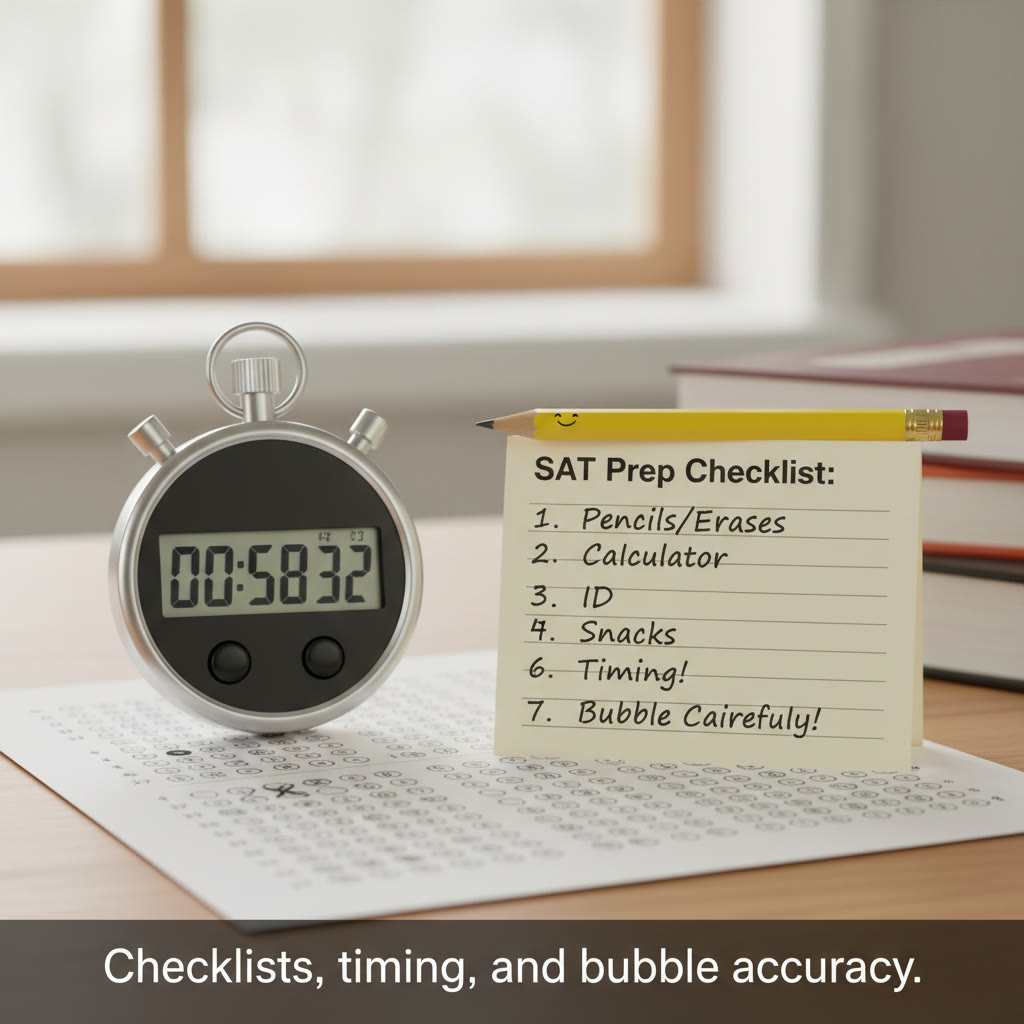The Quiet Power of the ‘Easy’ Questions
When most students sit for SAT practice tests or the real thing, their eyes are drawn to the monsters: dense reading passages, multi-step math problems, and questions that demand juggling rules and logic. That instinct makes sense. Hard questions feel like the gatekeepers of a high score. But here’s a counterintuitive truth: the questions labeled “easy” on the SAT are where a surprisingly large share of scoring opportunity — and scoring risk — lives.
This piece is about why those easy questions deserve your attention, how small habits you build around them can compound into significant point gains, and practical methods to make reviewing easy questions fast, precise, and habit-forming. Along the way you’ll find real examples, a data table that clarifies trade-offs, and actionable routines that fit into daily study. I’ll also explain how focused, personalized support — for instance Sparkl’s personalized tutoring with 1-on-1 guidance, tailored study plans, expert tutors, and AI-driven insights — can accelerate the process if you want guided practice.
Why students gloss over easy questions
There are three common reasons learners rush past or give little thought to easy questions:
- Overconfidence: If a question seems straightforward, students assume they’ve got it. That leads to careless answer marking without a moment of double-checking.
- Time allocation bias: Students think, “I’ll spend my time on the hard ones,” which can be smart in moderation but dangerous when it means neglecting accuracy on easy items.
- Fatigue and inattentiveness: Easy questions can appear late in sections. After wrestling with hard problems, attention can dip precisely when the exam asks for simple precision.
Once you accept that easy questions can be traps, the next step is learning how to protect points efficiently. The goal isn’t to spend too much time re-checking everything; it’s to adopt high-value habits that catch the common mistakes without wasting minutes.
How easy questions hide big point losses
There are several ways a seemingly trivial question turns into a missed point:
- Careless arithmetic or sign errors that flip a correct answer to an incorrect one on a math question worth a point.
- Misreading a modifier or scope in a sentence on Writing & Language, turning a grammatical fix into an incorrect edit.
- Slipping past a subtle qualifying word on Reading — words like “usually,” “most,” or “always” change the correct answer dramatically.
- Bubble errors — marking the right letter in the wrong row or column on the answer sheet, a classic and tragic mistake.
Miss three or four of these ‘easy’ questions and you might lose 40–80 scaled points — enough to move from one scholarship band to another. The math is simple: the SAT converts raw scores to scaled scores, and while conversion varies, each raw point is often worth several scaled points depending on section and test. So the cumulative effect of small, avoidable mistakes is substantial.
Example: a tiny math slip that costs dearly
Consider a no-calculator math question that appears simple on first glance:
“If 3(x + 4) = 27, what is x?”
Most students do this in one step: divide both sides by 3 to get x + 4 = 9, then x = 5. But a distracted student might write x + 4 = 9, then mis-subtract and bubble in 4, or misread the question and solve for 3x = 27. In a timed environment those tiny lapses happen fast.
The fix is not to spend an extra minute on every easy problem. It’s to develop a quick, 10-second review checklist for each question you answer: Did I copy the right numbers? Did I perform the operation correctly? Is the answer reasonable? That small habit catches most of these common mistakes.
Data-driven perspective: time vs. points
To decide how much time to invest in reviewing easy questions, it helps to look at a simple hypothetical scenario. The table below compares three review strategies and their expected yield over a 20-question block of easy-to-medium items.
| Strategy | Average review time per question | Estimated error rate before review | Estimated error rate after review | Expected points saved per 20 questions |
|---|---|---|---|---|
| No review | 0 seconds | 8% | 8% | 1.6 points lost (expected) |
| Quick 10-second checklist | 10 seconds | 8% | 2% | 1.2 points saved (expected) |
| Detailed 30-second rework | 30 seconds | 8% | 0.5% | 1.6 points saved (expected) |
Notes on the table: these are illustrative numbers, not exact statistics. The point is to show the trade-off between time and accuracy. A quick 10-second checklist can recover most of the points you’d get from a longer rework, but with less time cost. The detailed rework gives slightly more security at a higher time cost. Which is right depends on the section, your personal error patterns, and the time you have left on test day.
Section-by-section strategies: where easy questions are most vulnerable
Reading
Easy Reading questions are often those that ask about explicit facts, main idea of a paragraph, or straightforward inference. The traps here are fast misreads and overlooking qualifiers.
- Always underline the phrase the question targets. If it asks about “the author’s tone in paragraph 2,” put a quick mark near that sentence before you answer.
- Compare answer choices one at a time to the passage. Don’t pick the first tempting answer — scan the others for a subtle improvement.
- Watch for extreme wording (“always,” “never”) versus temperate wording (“often,” “usually”). The SAT favors tempered choices unless the passage explicitly uses the extreme word.
Example pitfall: A question asks, “What does the narrator most likely believe about X?” If the passage says “The narrator usually walks to work,” the answer “The narrator always walks to work” is wrong even though it sounds similar. Easy mistake, big impact.
Writing & Language
For Writing & Language, easy questions test grammar rules, punctuation, and clarity. Many mistakes here come from reading too quickly or choosing an answer that sounds correct without checking structure.
- Read the full sentence aloud in your head before choosing. If something sounds off, pause and test each answer for flow and correctness.
- Learn quick cues: subject-verb agreement, pronoun reference, and parallel structure are frequent easy items.
- When choosing between concise and wordy options, favor the concise answer if meaning stays the same — but confirm no nuance is lost.
Example pitfall: The choices change verb tense in subtle ways. If the original sentence references a universal truth, switching to past tense for no reason is wrong, even if it seems grammatically fine.
Math (No Calculator and Calculator)
Many math ‘easy’ questions are arithmetic, simple algebra, or common geometric facts. Careless arithmetic, sign errors, and mis-copied numbers are the usual culprits.
- When using a calculator, re-enter the original equation to verify the displayed answer before bubbling it.
- On no-calculator problems, do a fast mental estimation after solving: does your answer make sense? If the numbers are large, check magnitude and sign.
- For grid-in answers, double-check your digit order and decimal placement before you fill the bubble grid.
Example pitfall: You solve and get x = -4, but the question asked for |x|. Marking -4 instead of 4 is a simple oversight that costs the point.
Practical review habits that don’t waste time
The magic is building tiny, repeatable review habits that catch most errors without adding minutes to your test time. Here are several routines you can test and adapt.
The 10-second checklist (repeatable, universal)
- Did I read the question and the answer I bubbled? (2 seconds)
- Does the answer fit the context or units? (2–3 seconds)
- Quick mental recalculation or rephrase: is the answer plausible? (3–4 seconds)
- If it’s a grid-in, is the digit order correct? (2 seconds)
This is the single highest-yield routine. It’s fast and catches the majority of careless mistakes.
Two-minute recheck at section midpoints
Instead of reworking every easy question individually, schedule a short checkpoint roughly halfway through each section. Use those two minutes to skim your answers to the easy items: confirm numbers, check bubbles, and flag anything that felt uncertain. This is particularly effective on the Math sections where small numerical mistakes are common.
Flag-and-come-back method
If a question takes longer than your target time, flag it and move on. After finishing easier items and when time permits, come back to flagged items. This prevents you from draining time on one problem and missing easy ones later.
Practice drills that reinforce careful habits
Drills that simulate review habits are more valuable than endless question collections. Here are some high-impact drills:
- Timed 10-second check drill: Do a 20-question block and practice applying the 10-second checklist after every answer. Time yourself and log how many errors the checklist catches over multiple sessions.
- Bubble accuracy exercise: Simulate a paper test and practice bubbling. Then deliberately introduce a mis-copy error and practice catching it during your review.
- Backwards-checking drill (Math): Solve five problems normally, then check each by plugging your answer back into the original equation or by estimating. This builds the intuition that verifies answers quickly.
When personalized help speeds progress
Personalized tutoring can transform the way you approach easy-question review. A tutor who watches you work will quickly spot patterns: are your mistakes mostly arithmetic slips, misreadings, or timing issues? Sparkl’s personalized tutoring offers 1-on-1 guidance, tailored study plans, expert tutors, and AI-driven insights that can identify the most frequent, low-cost fixes for your specific habit profile. That means you spend less time guessing which habits to change and more time practicing the precise checks that yield points.
For instance, if a student consistently misses Reading questions because of misinterpreting qualifiers, a tutor can create targeted reading exercises and track progress. If arithmetic slips are common, the tutor might focus on mental-check tactics and calculator confirmation habits. AI-driven insights can highlight trends in your wrong answers, so every tutoring minute produces measurable improvement.
How to use practice test reviews to learn faster
Practice tests are where the review of easy questions becomes a skill, not just a habit. When you score a full-length test, your review should focus first on easy questions you missed. Why? Because those mistakes are low-hanging fruit: they’re often fastest to correct and offer immediate score uplift.
Post-test checklist
- Identify every missed question and classify it: carelessness, knowledge gap, or time management.
- For careless errors on easy questions, ask: what check would have caught this? Add that check to your routine.
- For knowledge gaps, create a short targeted drill to fix the underlying skill.
- For time-management errors, plan how to adjust pacing and use flagging more effectively.
Common student questions and short answers
Should I always recheck every answer?
No. That’s inefficient. Use a quick checklist for most questions and reserve deeper rechecks for flagged or uncertain items.
How much time should I budget per easy question?
Use the 10-second checklist. If something still feels off, invest up to 30 seconds. The idea is to prevent habitual errors, not to re-solve the problem from scratch.
Will this slow me down on hard questions?
Not if you practice. The 10-second review becomes automatic with repetition. Flagging ensures you don’t lose momentum on harder items.
Putting it all together: a simple 4-week practice plan
Here’s a pragmatic plan that balances practicing hard problems with disciplined review of easy questions:
- Week 1: Build the 10-second checklist. Do 30–40 easy-to-medium questions daily and apply the checklist after each answer.
- Week 2: Add the two-minute midpoint recheck in section practice. Take one full section test and practice the checkpoint strategy.
- Week 3: Focus on weak areas identified by your practice tests. Use targeted drills for those easy questions you keep missing.
- Week 4: Simulate full tests under timed conditions, using flagging, the 10-second checklist, and the midpoint recheck. Review missed easy questions first after each test.
If you have access to personalized tutoring, fold in weekly sessions where a tutor observes your process and helps refine your checklist. Sparkl’s personalized tutoring, with tailored study plans and AI-driven insights, can accelerate this cycle by making every practice minute smarter and more focused on your specific error patterns.
Image ideas to complement this article


Final thoughts: small corrections, big returns
There’s a quiet genius in paying attention to the easy stuff. On the SAT, where every point matters and many students miss easy problems for careless reasons, the simple act of building reliable, fast review routines can produce outsized score gains. You don’t need to rework every problem. You need habits that catch common mistakes — and the discipline to apply them consistently.
If you want to speed up that learning curve, consider focused help. A tutor can watch your pacing, point out recurring slips, and help design a lightweight checklist tailored to you. For many students, Sparkl’s personalized tutoring — combining 1-on-1 guidance, tailored study plans, expert tutors, and AI-driven insights — is the way to turn small corrections into steady, measurable improvement.
On test day, the difference between a confident, careful student and a rushed, overconfident one is often only a few seconds per question. Build those seconds into reliable rituals, and you’ll find that the easy questions stop being a liability and become a steady source of points.
Now: pick one habit from this article and try it during your next practice session. It won’t solve every problem overnight, but after a few practice tests you’ll see how much those tiny lifts add up.
Good luck — and enjoy the satisfaction of collecting the easy points you deserve.













No Comments
Leave a comment Cancel